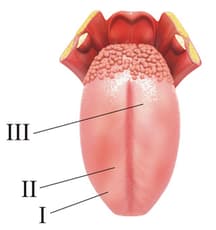EASY
Earn 100
What is bolus?
Important Questions on Digestion and Absorption
MEDIUM
EASY
EASY
EASY
EASY
EASY
EASY
EASY
EASY
MEDIUM
EASY
EASY
EASY
Study the following diagram of human tongue and identify the part I, II, and III

EASY
EASY
EASY
MEDIUM
EASY
EASY
| Column – I | Column – II | ||
|---|---|---|---|
| Crypts of Lieberkuhn | Pancreas | ||
| Glisson’s capsule | Duodenum | ||
| Islets of Langerhans | Small intestine | ||
| Brunner’s Glands | Liver |
Select the correct option.
MEDIUM

